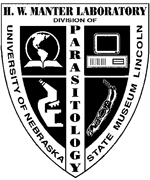Parasitology, Harold W. Manter Laboratory of

Harold W. Manter Laboratory of Parasitology: Library Materials
Document Type
Article
Date of this Version
4-6-2010
Citation
PLoS Neglected Tropical Diseases (2010) 4(4): e647
doi: 10.1371/journal.pntd.0000647
Abstract
Background: Pentastomiasis is a rare parasitic infection of humans. Pentastomids are dioecious obligate parasites requiring multiple hosts to complete their life cycle. Despite their worm-like appearance, they are commonly placed into a separate sub-class of the subphylum Crustacea, phylum Arthropoda. However, their systematic position is not uncontested and historically, they have been considered as a separate phylum.
Methodology/Principal Findings: An appraisal of Armillifer agkistrodontis was performed in terms of morphology and genetic identification after its lifecycle had been established in a multi-host model, that is, mice and rats as intermediate hosts, and snakes (Agkistrodon acutus and Python molurus) as definitive hosts. Different stages of the parasite, including eggs, larvae and adults, were isolated and examined morphologically using light and electron microscopes. Phylogenetic and cluster analysis were also undertaken, focusing on the 18S rRNA and the Cox1 gene. The time for lifecycle completion was about 14 months, including 4 months for the development of eggs to infectious larvae in the intermediate host and 10 months for infectious larvae to mature in the final host. The main morphological difference between A. armillatus and Linguatula serrata is the number of abdominal annuli. Based on the 18S rRNA sequence, the shortest hereditary distance was found between A. agkistrodontis and Raillietiella spp. The highest degree of homology in the Cox 1 nucleic acid sequences and predicted amino acid sequences was found between A. agkistrodontis and A. armillatus.
Conclusion: This is the first time that a multi-host model of the entire lifecycle of A. agkistrodontis has been established. Morphologic and genetic analyses supported the notion that pentastomids should be placed into the phylum Arthropoda.


Comments
Copyright 2010, the authors. Open access material
License: Creative Commons Attribution